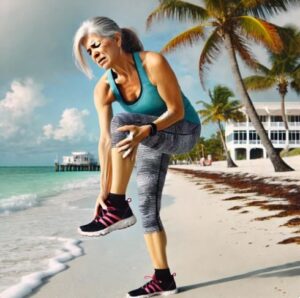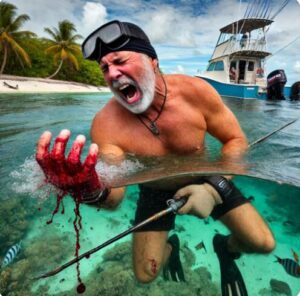Share this post
Jet Skiing Whiplash: The Hidden Risk of High-Speed Fun in Key West
Jet skiing near Sunset Key is an exhilarating experience, but when high speeds meet turbulent waters, accidents can happen in an instant. A 42-year-old male working near The Green Parrot recently learned this the hard way after suffering whiplash and cervical strain from a sudden stop on rough water. While many associate whiplash with car accidents, experts like Dr. Jason Pirozzolo explain that high-impact water sports also pose a significant risk. The force of rapid acceleration, combined with an unexpected stop, can lead to severe neck strain, muscle spasms, and prolonged discomfort.
Understanding Whiplash and Cervical Strain
Whiplash occurs when the neck is forcefully thrown forward and backward, straining the muscles, ligaments, and soft tissues. The condition is common in high-speed activities, including jet skiing, water tubing, and wakeboarding.
According to Dr. Jason Pirozzolo, the nature of jet skiing injuries is unique. “Unlike car accidents, where seat belts provide some stability, water sports offer little neck support. When a jet ski stops suddenly or hits a wave the wrong way, the head keeps moving, causing violent hyperextension of the neck muscles.”
Cervical strain, often accompanying whiplash, results from overstretching the soft tissues of the neck. Symptoms may not appear immediately, but within hours or days, individuals can experience:
- Neck stiffness and pain
- Headaches at the base of the skull
- Limited range of motion
- Upper back and shoulder pain
- Tingling or numbness in the arms
Why Whiplash from Jet Skiing Is Often Underestimated
Most people assume neck pain after jet skiing is temporary and will subside with rest. However, Dr. Jason Pirozzolo warns against ignoring persistent symptoms.
“Neck injuries should never be taken lightly. Even a mild case of whiplash can lead to chronic pain, nerve irritation, and reduced mobility. If symptoms worsen over time, it may indicate a more serious spinal issue, such as a herniated disc or nerve compression.”
Treatment and Recovery for Whiplash and Cervical Strain
Recovering from whiplash or cervical strain depends on the severity of the injury. Dr. Jason Pirozzolo outlines the best treatment options for pain relief and rehabilitation.
1. Rest and Activity Modification
- Avoid high-impact activities for at least a week.
- Minimize movements that trigger pain or stiffness.
- Use a supportive neck pillow while sleeping.
2. Cold and Heat Therapy
- Apply ice packs for 15-20 minutes in the first 48 hours to reduce swelling.
- Switch to heat therapy to relax tight muscles and improve blood circulation.
3. Gentle Neck Exercises
- Start with slow, controlled stretches to restore mobility.
- Perform chin tucks, side rotations, and shoulder rolls to reduce stiffness.
- Gradually increase resistance training to strengthen neck muscles.
4. Pain Management Options
- Over-the-counter NSAIDs (ibuprofen or naproxen) help reduce inflammation.
- Muscle relaxants may be prescribed for severe spasms.
- If pain persists, physical therapy or trigger point injections may be necessary.
Preventing Jet Ski Injuries: Dr. Jason Pirozzolo’s Advice
While whiplash and cervical strain can happen unexpectedly, Dr. Jason Pirozzolo stresses that simple precautions can reduce the risk of injury.
1. Strengthen the Neck and Upper Body
- Perform neck stabilization exercises before high-impact activities.
- Strengthen shoulder and core muscles to improve postural control.
2. Maintain Proper Jet Ski Posture
- Keep knees slightly bent and abs engaged.
- Avoid locking the elbows or stiffening the neck.
- Anticipate wave movements to prevent sudden jerks.
3. Wear a High-Quality Life Jacket
- A properly fitted life jacket provides stability in case of falls.
- Choose a vest with neck support for extra protection.
4. Be Mindful of Water Conditions
- Avoid riding in choppy waters if you lack experience.
- Maintain a safe speed, especially near docks and other vessels.
- Gradually decelerate instead of stopping abruptly.
When to Seek Medical Attention for Whiplash
While many whiplash cases resolve with conservative treatment, Dr. Jason Pirozzolo advises seeking medical care if symptoms include:
- Severe pain that worsens over time
- Dizziness, nausea, or blurred vision
- Tingling, numbness, or weakness in arms
- Difficulty concentrating or memory problems
- Persistent headaches
These symptoms may signal neurological involvement, requiring imaging tests like X-rays or MRIs to rule out spinal cord injuries.
Cutting-Edge Treatments for Chronic Whiplash Pain
Advancements in sports medicine provide new options for chronic whiplash sufferers. Dr. Jason Pirozzolo highlights some promising therapies:
- Platelet-Rich Plasma (PRP) Therapy: Uses growth factors from the patient’s blood to promote tissue repair.
- Chiropractic Adjustments: Helps restore alignment and relieves nerve compression.
- Dry Needling and Acupuncture: Targets trigger points to reduce muscle tension.
- Ultrasound Therapy: Stimulates deep tissue healing through sound waves.
Key Takeaways: Enjoying Water Sports Safely
Jet skiing in Key West offers unmatched excitement, but safety should always come first. Dr. Jason Pirozzolo encourages water sports enthusiasts to prioritize injury prevention by following proper techniques, conditioning exercises, and protective gear recommendations.
If you or someone you know has experienced a whiplash injury, consult a sports medicine expert like Dr. Jason Pirozzolo for a personalized treatment plan. His expertise ensures patients receive the best care for a quick and effective recovery.
For expert advice on sports injuries, recovery strategies, and cutting-edge treatments, follow Dr. Jason Pirozzolo for insights into the latest developments in sports medicine. You may also visit a Key West orthopedic clinic for more information.
Disclaimer: The scenario is based on true events; however, names, locations, and details have been altered to protect privacy.




















